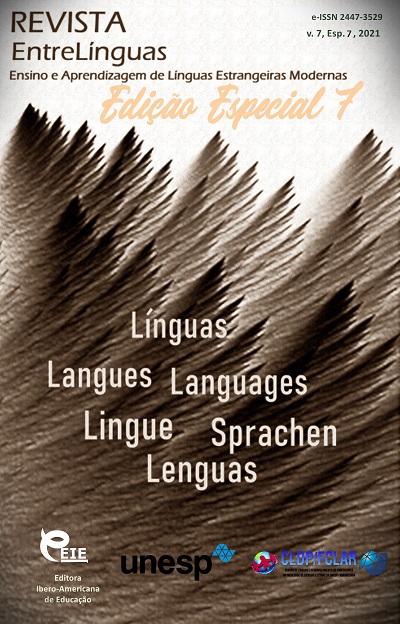Análise linguística do texto político: estrutura e funções do endereço eleitoral
DOI:
https://doi.org/10.29051/el.v7iesp.7.16299Palavras-chave:
Linguística, Influência do discurso, Texto político, Comunicação políticaResumo
O estudo investiga a linguagem e a estrutura de gênero e a formação de um determinado tipo de texto político, um discurso eleitoral de um líder político ao eleitorado. O artigo considera a história do surgimento do gênero discurso público no discurso político russo, suas funções e características linguísticas que resolvem o problema de revelar o conteúdo ideológico principal no nível lexical. O material de pesquisa foram os textos dos discursos eleitorais de Gennady Zyuganov em 2000 e 2019 retirados de fontes da Internet e os comentários que os acompanham, estimados em cerca de 50 fontes. No decorrer do estudo, as características linguísticas das implementações das funções de endereço político (influência, inspiração, advocacia e propaganda, informar), típicas deste tipo de declarações políticas, são reveladas juntamente com a dinâmica estabelecida de mudanças na retórica por Gennady Zyuganov como líder de um partido político e seu principal representante.
Downloads
Referências
Altunyan, A.G. (2006). Analiz politicheskih tekstov: uch. Posobie. – M.: Universitetskaya kniga; Logos, 384 s. (in Russian)
Bayley, P. (1985). Live oratory in the television age: The language of formal speeches // G. Ragazzini, D.R.B.P. Miller eds. Campaign language: Language, image, myth in the U.S. presidential elections 1984. – Bologna: Cooperativa Libraria Universitaria Editrice Bologna, 1985. P. 77-174.
Belyanin, V. P. (1996). Introduction to psychiatric literature.– Verlag Otto Sagner. Specimina Philologiae Slavicae. Band 107. – Munchen,. – 298 p.
Belyanin, V.P. (2009). Psycholinguistics. Textbook.– Moscow: Flinta: Moscow Psychological and Social Institute, – 416 p. (Student library/ Russian Academy of Sciences education, Mosc. Psych. and Soc. Inst.). – ISBN 5-89349-371-0 (Flinta) – ISBN 5-89502-421-1 (MPSI).
Garcia Santos, J.F. (1987). El lenguaje politico: En la Secunda Republica y en la Democracia. M. Alvar ed. El lenguaje politico. – Madrid: Fundacion Friedrich Ebert, Instituto de Cooperacion Iberoamericana, 1987. P. 89-122.
Ilikova, L. (2019). The five-star movement: From a blog to Italian government. Sovremennaya Evropa, 4, 129-140.
Morik, K. (1982). Uberzeugungssysteme der Kunstlichen Intelligenz: Validierung vor dem Hintergrund linguistischer Theorien uber implizite Ausserungen. Tubingen: Niemeyer, 269 p.
Tarasov, E.F. (1990). Speech impact: methodology and theory Text]. Optimization of speech influence [ed. by R. G. Kotov]. – Moscow: Nauka, 5-18.
Tushev, A., Bushkanets, L., Letyaev, V. (2019). Complex analysis of political speech. Journal of Sociology and Social Anthropology, 10(4),170-174.
Valgina, N.S. (2003). Theory of the text: textbook / Valgina N. S. – Publishing house: Logos, – 280 p.
Van Dijk Ten, A. (2013). Diskurs i vlast': Reprezentaciya dominirovaniya v yazyke i kommunikacii. — M.: Knizhnyj dom «LIBROKOM»,. — 344 s. (in Russian)
Wodak, R. (1997). Language. Discourse. Politics / Translated from English and German. – Volgograd: "Change", – 139 p.
Downloads
Publicado
Como Citar
Edição
Seção
Licença

Este trabalho está licenciado sob uma licença Creative Commons Attribution-NonCommercial-ShareAlike 4.0 International License.
Os manuscritos aceitos e publicados são de propriedade da Revista EntreLínguas. Os artigos publicados e as referências citadas na Revista EntreLínguas são de inteira responsabilidade de seus autores.
Transferência de direitos autorais – autorização para publicação
Caso o artigo submetido seja aprovado para publicação, já fica acordado que o(s) autor(es) autoriza(m) a UNESP a reproduzi-lo e publicá-lo na EntreLínguas, entendendo-se os termos “reprodução” e “publicação” conforme definição respectivamente dos incisos VI e I do artigo 5° da Lei 9610/98. O artigo poderá ser acessado pela rede mundial de computadores (Internet), sendo permitidas, a título gratuito, a consulta e a reprodução de exemplar do artigo para uso próprio de quem a consulta, desde que haja a citação ao texto consultado. Essa autorização de publicação 328 EntreLínguas, Araraquara, v. 1, n .2, p. 323-328, jul./dez. 2015 não tem limitação de tempo, ficando a UNESP responsável pela manutenção da identificação do(s) autor(es) do artigo. Os artigos publicados e as referências citadas na Revista EntreLínguas são de inteira responsabilidade de seus autores.











